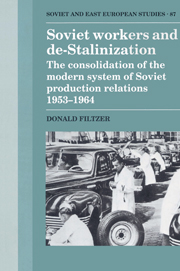 Soviet Workers and De-Stalinization
Soviet Workers and De-Stalinization Book contents
- Frontmatter
- Contents
- List of tables
- Preface and acknowledgements
- List of terms and abbreviations
- Introduction: the contradictions of-Stalinization
- Part I Labour policy under Khrushchev: issues and results
- 1 The worker and the work environment
- 2 The reform of labour legislation and the re-emergence of the labour market
- 3 The labour shortage
- 4 The wage reform
- Part II De-Stalinization and the Soviet labour process
- Conclusion
- Notes
- Bibliography
- Index of industrial, mining, and construction enterprises
- General index
- Soviet and East European Studies
4 - The wage reform
Published online by Cambridge University Press: 29 January 2010
- Frontmatter
- Contents
- List of tables
- Preface and acknowledgements
- List of terms and abbreviations
- Introduction: the contradictions of-Stalinization
- Part I Labour policy under Khrushchev: issues and results
- 1 The worker and the work environment
- 2 The reform of labour legislation and the re-emergence of the labour market
- 3 The labour shortage
- 4 The wage reform
- Part II De-Stalinization and the Soviet labour process
- Conclusion
- Notes
- Bibliography
- Index of industrial, mining, and construction enterprises
- General index
- Soviet and East European Studies
Summary
If, as I have argued so far, the central task of de-Stalinization was to improve economic efficiency and raise productivity, the true centrepiece of this strategy was the wage reform. The reform was first introduced into coal-mining and some engineering enterprises in 1956, covered all major branches of industry by 1960, and the rest of the economy by 1962. The reform sought to re-establish what the regime considered to be a systematic relationship between the price paid for labour power and the amount of labour performed, a relationship which had broken down during the 1930s under the pressures of industrialization and had deteriorated even further in the last years of Stalin's reign. While the reform achieved some of its more nominal objectives, such as reducing levels of norm overfulfilment and the weight of norm-overfulfilment payments in piece workers' earnings, it did not succeed in turning Soviet wages into a coherent, predictable, and centrally controllable system of incentives.
This is not to deny that the reform also had other goals. For example, it sought to ease the plight of the very low-paid, although, as we shall see, the actual narrowing of differentials among wage labourers was at best modest. Similarly, the regime attempted to use wages policy to influence the allocation of labour between industries and regions. Here, too, the results were questionable. In Siberia and the Far East the application of so-called extra ‘zonal’ payments singularly failed to stem population-loss and high labour turnover in these regions.
- Type
- Chapter
- Information
- Soviet Workers and De-StalinizationThe Consolidation of the Modern System of Soviet Production Relations 1953–1964, pp. 92 - 118Publisher: Cambridge University PressPrint publication year: 1992
